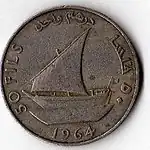| دينار اليمن الجنوبي | |
|---|---|
| ISO 4217 | |
| Code | YDD |
| Unit | |
| Symbol | £ |
| Denominations | |
| Subunit | |
| 1⁄1000 | fils |
| Banknotes | 500 fils, £1, £5, £10 |
| Coins | 2+1⁄2, 5, 10, 50, 100, 250 fils |
| Demographics | |
| User(s) | |
| Issuance | |
| Central bank | Bank of Yemen |
| This infobox shows the latest status before this currency was rendered obsolete. | |

The dinar (Arabic: دينار) (Arabic: مؤسسة النقد للجنوب العربي; sign: £) was the currency of South Arabia and then South Yemen between 1965 and 1990. It was subdivided into 1000 fils (فلس). After Yemen's monetary unification on 1 July 1990, it was one of the two official currencies used in Yemen Republic until 11 June 1996.
History
The dinar was introduced in 1965 as the South Arabian dinar, replacing the East African shilling at a rate of 1 dinar = 20 shillings, thus setting the dinar initially equal to one pound sterling, it also used the pound sign as its Latin script symbol. It was renamed the South Yemeni dinar after the Federation of South Arabia and the Protectorate of South Arabia united in 1967 as independent South Yemen. The South Yemeni dinar was replaced with the Yemeni rial following unification with North Yemen in 1990. Dinar banknotes remained legal tender during a transitional period until 1996. The exchange rate during that period was £1 = 26 YER.
For a wider history surrounding currency in the region, see British currency in the Middle East.
Coins
In 1965, coins (dated 1964) were introduced for both the Federation of South Arabia and the Protectorate of South Arabia in denominations of 1, 5, 25 and 50 fils. The 1 fils was struck in aluminium, the 5 fils in bronze and the higher two denominations in cupro-nickel.
In 1971, coins were issued in the name of "Democratic Yemen", changing to the "People's Democratic Republic of Yemen" in 1973. That year, aluminium 2+1⁄2 fils were introduced, followed by aluminium 10 fils and cupro-nickel 100 and 250 fils in 1981. The 10 fils was scalloped shaped whilst the 100 fils was octagonal.
Banknotes
On 1 April 1965, the South Arabian Currency Authority introduced notes in denominations of 250 fils, 500 fils, 1 dinar, and 5 dinars. A 10 dinar note was issued on 1 July 1967.[1]
In 1984, the Bank of Yemen introduced 500 fils as well as 1 dinar, 5 dinar, and 10 dinar notes that are like the preceding issues of South Arabia, except the English text and printer's imprint have been removed from the front, the name of the issuer has changed and now appears on the back, along with the name of the capital (ADEN).[2]
References
- ↑ Linzmayer, Owen (2012). "South Arabia". The Banknote Book. San Francisco, CA: www.BanknoteNews.com.
- ↑ Linzmayer, Owen (2012). "Democratic Republic of Yemen". The Banknote Book. San Francisco, CA: www.BanknoteNews.com.
- Krause, Chester L.; Clifford Mishler (1991). Standard Catalog of World Coins: 1801–1991 (18th ed.). Krause Publications. ISBN 0873411501.
- Pick, Albert (1994). Standard Catalog of World Paper Money: General Issues. Colin R. Bruce II and Neil Shafer (editors) (7th ed.). Krause Publications. ISBN 0-87341-207-9.
Value
| Value | Obverse | Reverse | date |
|---|---|---|---|
| 10 fils |  |
 | 1981 |
| 50 fils |  |
 | 1964 |
| 50 fils |  |
 | 1979 |
| 100 fils |  |
 | 1981 |
| 250 fils |  |
 | 1981 |
External links
| Preceded by: East African shilling Ratio: 1 dinar = 20 shillings = 1 British pound |
Currency of South Yemen 1965 – 1990 |
Succeeded by: Yemeni rial Reason: unification with North Yemen to form Yemen Ratio: 1 dinar = 26 rials |